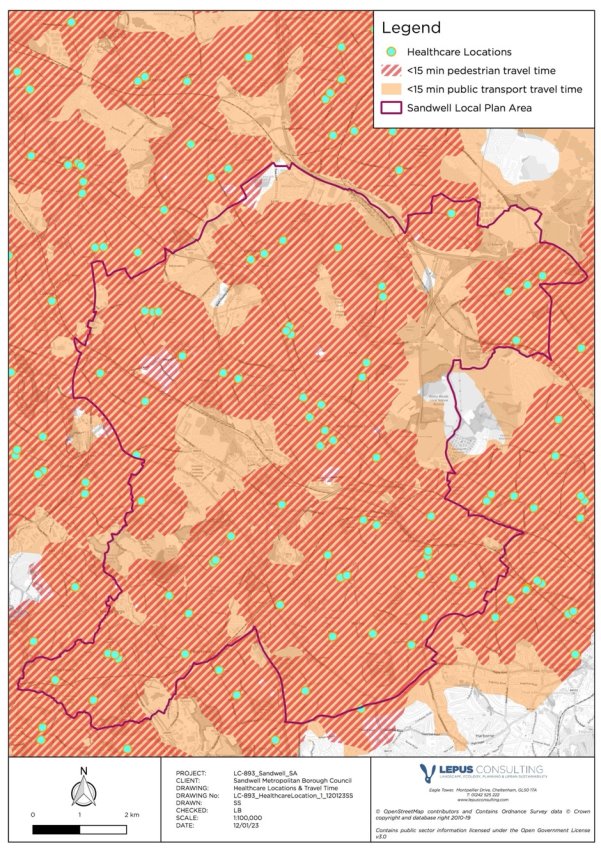Sustainability Appraisal of the Sandwell Local Plan 2024-2041
11 Human health
11.1 Introduction
11.1.1 National and local health strategies and policies seek to promote the development of healthy communities, such as through delivering age-friendly environments for the elderly, encouraging healthier food choices and facilitating active travel. In line with the NPPF, local planning authorities should seek to promote social interaction, create communities which are safe and accessible, and ensure there is good accessibility to a range of GI, sports facilities, local shops, cultural buildings and outdoor space.
11.1.2 Key PPPs include Public Health England's Strategy for 2020 – 2025[93] which sets out priorities within the health system including a focus on addressing health inequalities, an issue that is particularly relevant for Sandwell.
11.2 Baseline and key issues
Air quality
11.2.1 As discussed in Chapter 7, the entirety of the SLP area is designated as an AQMA. Development proposals located within an AQMAs, and particularly those in close proximity to main roads, are likely to expose site end users to transport associated noise and air pollution, with adverse impacts on health and wellbeing such as respiratory conditions, cardiac health and cancer.
11.2.2 As all proposed development in Sandwell will be located within an AQMA, this is likely to lead to adverse impacts on health and may prevent the Council from achieving air quality targets. It is assumed that new development proposals would result in an increase in traffic and thus could potentially increase traffic-related air pollution. Both existing and future residents would be exposed to this change in air quality.
Healthcare facilities
11.2.3 In order to facilitate healthy and active lifestyles for existing and new residents, the SLP should seek to ensure that residents have good access to NHS hospitals and GP surgeries.
11.2.4 Healthcare provision within the SLP area includes Sandwell General Hospital and Midland Metropolitan University Hospital[94] which is due to open in 2024, both of which provide an A&E services, and a total of 73 healthcare centres. Ideally, residents should be within an approximate ten-minute walking distance to their nearest GP surgery, whilst a hospital within 5km would be considered a sustainable distance. According to accessibility modelling data[95], almost the entirety of Sandwell lies within a sustainable 15-minute walking distance or travel time via public transport to a GP surgery (see Figure 11.1).

Figure 11.1: Location of healthcare facilities and modelled travel time across the SLP area (source: SMBC)
Green spaces
11.2.5 Opportunities to experience a diverse range of natural habitats and recreational spaces is known to be beneficial for physical and mental health and wellbeing. Good access to such areas can reduce stress, fatigue, anxiety and depression[96], and has been linked with healthy foetal growth in pregnant women, higher birth weights, healthy microbiomes in babies and reduced rates of obesity and type 2 diabetes. Impacts of restricted access to the natural environment are particularly significant for lower socio-economic groups.
11.2.6 Providing residents with sustainable access to a diverse range of natural habitats can be an effective means of reducing health inequalities in the area. According to the Green Space Strategy[97], Sandwell contains a total of 539 green sites covering an area of 2,042ha, equivalent to 24% of the total area of the borough, with 14% being accessible green space. Key features include parks, nature reserves and play areas. Other key elements of outdoor recreational space include the PRoW network and the canal system, which serve a purpose in encouraging active travel.
11.2.7 The SLP area supports a network of biodiversity sites, providing local residents with opportunities to visit natural outdoor spaces and view wildlife (see Chapter 3).
Key issues for human health include:
- As all the proposed development within the SLP will be located within an AQMA, this is likely to lead to adverse impacts on health, without intervention.
- Residents in Sandwell experience significant inequalities in health, with residents having a lower life expectancy and experiencing illness and disability at a younger age on average, compared to other parts of England.
- The increasing population in Sandwell is likely to place pressure on the capacity of health infrastructure and leisure facilities, which will need careful planning.
- Anti-social behaviour is an issue within some of Sandwell's green spaces according to the Green Space Strategy, which may discourage their use by the local community. There is a need to establish greater management and maintenance of green spaces, and support more local involvement.
11.3 Impacts on human health
11.3.1 Box 11.1 presents a plan-wide summary of the adverse impacts on human health that have been identified through the SA process. These adverse impacts have been identified prior to considering opportunities for mitigation.
Box 11.1: Summary of identified impacts on human health
Impact on human health
Summary of identified impact

Sustainable access to healthcare facilities
Sandwell is a predominately urban area, and as a consequence has access to a large number of health facilities. Sandwell General Hospital, as well as the Midland Metropolitan University Hospital (as of Autumn 2024) provides A&E services to the borough, and most areas have access to GP surgeries and leisure facilities. Where there is more limited access to these facilities, residents may be discouraged from living active and healthy lifestyles, which could potentially have adverse impacts on mental wellbeing as well as physical health.
Some nine allocated sites are located outside of the 5km sustainable target distance to NHS hospitals providing an A&E service.
Some 12 allocated sites are located outside of the 15-minute travel time via walking to GP surgeries, and two allocated sites (SEC3-22 and SH19) are located outside of the 15-minute travel time via public transport to GP surgeries.

Exposure to air / noise pollution (from AQMAs / main roads)
The long-term health of residents, in particular vulnerable groups including children and the elderly, could be adversely affected by local reductions in air quality. This impact is discussed further in Chapter 7.
The entirety of the SLP area is classified as an AQMA, known as 'Sandwell AQMA'. Development within 200m of an AQMA or main road could potentially expose site end users to increased levels of traffic related air pollution or noise impacts, with adverse implications for health.
All allocated sites are located within Sandwell AQMA. In addition, the majority of site SH43 is located within 200m of Birmingham AQMA, and site SEC1-5 lies adjacent to Dudley AQMA.
Some 48 allocated sites are located within 200m of a main road, raising the potential for air quality impacts associated with atmospheric pollution from vehicular traffic at these sites.

Loss of public greenspace
Good access to public green or open spaces, a diverse range of natural habitats and travelling via walking and cycling are known to have physical and mental health benefits. Whilst there is generally good access to open space across Sandwell as a whole, there are spatial variations on existing access to different types and sizes of open space across different areas, and a total of eight sites have potential to result in a net loss of green space.

Limited access to PRoW or cycle network
The majority of allocated sites are located in areas with good coverage by the PRoW and/or cycle networks, providing many site end users with opportunities for active travel and recreation parks, open space or the surrounding countryside. However, 13 allocated sites are located beyond the sustainable target distance of 600m to a PRoW or cycle path, where site end users may have more limited opportunities for outdoor recreation and active travel.
11.4 Local Plan mitigation
11.4.1 Several SLP policies aim to promote healthy and active lifestyles for new and existing residents within the Plan area. Many of these policies are expected to result in benefits to human health, through the provision of open spaces, improvements to walking and cycling networks and improved sustainable transport and access to healthcare facilities. Mitigation is discussed further in Box 11.2.
Box 11.2: Mitigating effects of the Local Plan policies on human health
Policy mitigation for human health
Summary of mitigating effect

Sustainable access to healthcare facilities
Policy SDS1: Spatial Strategy for Sandwell seeks to direct housing growth towards locations with the highest levels of sustainable transport access to services including healthcare facilities.
Policy SHW1: Health Impact Assessments sets out the requirement for certain development proposals to undertake an HIA to ensure that adverse effects associated with physical and mental health and access to and demand for health and social care services are addressed, and that opportunities for promoting healthy lifestyles are maximised.
Policy SHW2: Healthcare infrastructure states that new healthcare facilities should be "well-designed" and "well-served by public transport infrastructure". Furthermore, the policy requires any development that has unacceptable impacts upon the functionality of healthcare facilities to "contribute to the provision or improvement of such services", and will ensure there is sufficient capacity in healthcare infrastructure to serve new growth.
Policy SDM9: Community facilities includes measures to increase provision for community and leisure facilities, which has potential to encourage site end users to live active and healthy lifestyles.
Policy STR1: Priorities for the development of the transport network states that "all new developments must provide adequate access for all modes of travel, including walking, cycling and public transport", which will likely improve access to healthcare and leisure facilities.
Exposure to air / noise pollution (from AQMAs / main roads)
Policy SHW3: Air quality will only permit development where it can be demonstrated that it will not further deteriorate existing poor air quality, supported by Policy SHWI: Health Impact Assessments. Any development that has potential to lead to significant adverse impacts on air quality will need to provide an air quality assessment.
Policy SCC2: Reducing operational carbon for new build non-residential development, supported by Policy SCC1: Energy Infrastructure, Policy SDS2: Increasing efficiency and resilience and Policy SDMI: Design Quality, promote energy-efficient development proposals which support low carbon technologies, which will likely result in a decrease of pollutant emissions from the construction and occupation of new development.
Various policies seek to improve traffic flow and promote sustainable and active modes of transport in order to avoid reductions in air quality, including Policy STR1: Priorities for the development of the transport network and Policy STR5: Creating coherent networks for cycling and walking, as well as policies STR2, STR3, STR4, STR6, STR8 and Policy STR9.
Policy SDS8: Green and Blue Infrastructure in Sandwell and Policy SNE3: Provision, retention and protection of trees, woodlands and hedgerows encourage enhancements to the provision and connectivity of GI/BI, which will help to support ecosystem service functions such as the filtration of air pollutants and could potentially result in reducing impacts from increased emissions.
Loss of public greenspace
Policy SDS1: Spatial Strategy for Sandwell will ensure that new public open spaces are created to serve new housing developments.
Policy SHW5: Playing fields and sports facilities and Policy SHW4: Open space and recreation will ensure sufficient greenspace and recreational space is available in Sandwell through addressing any shortfalls. These policies encourage wider community use of school playing fields and sports facilities as well as maintaining/enhancing the accessibility, quality and quantity of open spaces.
Policy SDS8: Green and blue infrastructure in Sandwell provides measures to support green and blue infrastructure within the borough, increasing green cover through contributing to the provision and function of greenspaces in Sandwell.
Limited access to PRoW or cycle network
Policy STR1: Priorities for the development of the transport network prioritises access for all modes of travel for new developments, including walking and cycling.
Policy STR5: Creating coherent networks for cycling and walking enables active travel through the provision of safe cycling and walking infrastructure, including the implementation of new cycle parking facilities, appropriate signage and active travel links to public transport.
Various SLP policies including Policies STR3: Managing transport impacts of new development, STR6: Influencing the demand for travel and travel choices, SHW2: Healthcare infrastructure, SHW3: Air quality and SDS5: Achieving well-designed places include measures that aim to improve accessibility to active travel routes.
11.5 Residual effects on human health
11.5.1 Many of the policies are expected to mitigate and result in positive impacts in relations to healthy lifestyles and access to healthcare facilities. Residual positive and negative effects of the SLP on human health are discussed in Box 11.3.
Box 11.3: Residual effects for human health
Residual effects
Further details of the residual effect
Limited sustainable access to healthcare facilities
The majority of site allocations are located within a sustainable target distance to an NHS hospital and GP surgery via walking and public transport methods. SLP policies, such as SHW1 and SHW2, are likely to increase sustainable access to facilities for a large number of residents, as well as improving the quality and capacity of existing services. Whilst the proposed growth within the SLP will be likely to increase demand for healthcare services, assuming that the SLP policies together with wider healthcare infrastructure improvements will ensure sufficient capacity to serve new development, an overall negligible effect is identified with regard to sustainable access to healthcare facilities and services.
Exposure to air / noise pollution (from AQMAs / main road)
SLP policies are expected to reduce some adverse impacts associated with the exposure of site end users to poor air quality within the Sandwell AQMA, and impacts associated with reduced air and noise quality alongside main roads.
The policies are expected to prevent unacceptable impacts on human health associated with air pollution but may lead to a cumulative adverse effect on air quality as a whole, which the policies in the Plan in itself cannot fully mitigate as it would require other transport interventions, for example the introduction of car-free zones.
Adverse impacts on human health resulting from exposure to poor air quality and noise pollution across the Plan area would be expected to be a long-term but potentially temporary significant effect.
Loss of public greenspace
Various SLP policies, as discussed within Box 11.2, seek to provide a range of open spaces, sports facilities and recreational spaces for site end users and compensate for any shortfalls, which will be expected to facilitate healthy and active lifestyles and supplement the borough's existing recreational resource. An overall positive effect is likely with regard to the provision of and access to green spaces.
Access to PRoW or cycle network
A large number of allocated sites are located within close proximity to existing PRoWs and cycle paths. Various SLP policies seek to promote cycling and walking which is likely to improve the coverage of, and accessibility to, the pedestrian, PRoW and cycle networks across Sandwell. This is expected to encourage residents to participate in physical exercise and active travel. An overall positive effect will be likely with regard to pedestrian and cycle access.
[93] Public Health England (2019) PHE Strategy 2020 to 2025. Available at: https://www.gov.uk/government/publications/phe-strategy-2020-to-2025 [Date accessed: 08/07/24]
[94]NHS (2024) NHS hospitals overview. Available at: https://www.nhs.uk/service-search/other-services/Accident-and- emergency-services/LocationSearch/428 [Date accessed: 20/08/24]
[95] Unpublished data provided to Lepus by the Council
[96] Houlden. V., Weich. S. and Jarvis. S. (2017) A cross-sectional analysis of green space prevalence and mental wellbeing in England
[97] Sandwell Metropolitan Borough Council Green Space Strategy 2022 – 2025. Available at: https://www.sandwell.gov.uk/downloads/download/109/green-spaces-strategy-implementation-and-business-plan-2223-–-2526 [Date accessed: 20/08/24]
